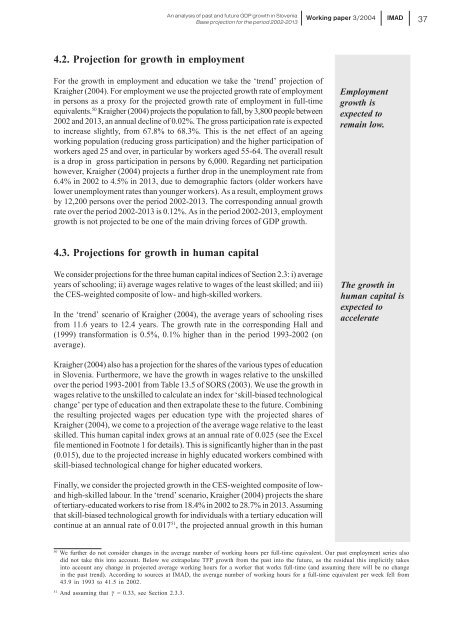Working papers published by IMAD ISSN: 1318-1920 ... - UMAR
Working papers published by IMAD ISSN: 1318-1920 ... - UMAR
Working papers published by IMAD ISSN: 1318-1920 ... - UMAR
Create successful ePaper yourself
Turn your PDF publications into a flip-book with our unique Google optimized e-Paper software.
An analysis of past and future GDP growth in Slovenia<br />
Base projection for the period 2002-2013<br />
<strong>Working</strong> paper 3/2004<br />
<strong>IMAD</strong><br />
37<br />
4.2. Projection for growth in employment<br />
For the growth in employment and education we take the ‘trend’ projection of<br />
Kraigher (2004). For employment we use the projected growth rate of employment<br />
in persons as a proxy for the projected growth rate of employment in full-time<br />
equivalents. 50 Kraigher (2004) projects the population to fall, <strong>by</strong> 3,800 people between<br />
2002 and 2013, an annual decline of 0.02%. The gross participation rate is expected<br />
to increase slightly, from 67.8% to 68.3%. This is the net effect of an ageing<br />
working population (reducing gross participation) and the higher participation of<br />
workers aged 25 and over, in particular <strong>by</strong> workers aged 55-64. The overall result<br />
is a drop in gross participation in persons <strong>by</strong> 6,000. Regarding net participation<br />
however, Kraigher (2004) projects a further drop in the unemployment rate from<br />
6.4% in 2002 to 4.5% in 2013, due to demographic factors (older workers have<br />
lower unemployment rates than younger workers). As a result, employment grows<br />
<strong>by</strong> 12,200 persons over the period 2002-2013. The corresponding annual growth<br />
rate over the period 2002-2013 is 0.12%. As in the period 2002-2013, employment<br />
growth is not projected to be one of the main driving forces of GDP growth.<br />
Employment<br />
growth is<br />
expected to<br />
remain low.<br />
4.3. Projections for growth in human capital<br />
We consider projections for the three human capital indices of Section 2.3: i) average<br />
years of schooling; ii) average wages relative to wages of the least skilled; and iii)<br />
the CES-weighted composite of low- and high-skilled workers.<br />
In the ‘trend’ scenario of Kraigher (2004), the average years of schooling rises<br />
from 11.6 years to 12.4 years. The growth rate in the corresponding Hall and<br />
(1999) transformation is 0.5%, 0.1% higher than in the period 1993-2002 (on<br />
average).<br />
The growth in<br />
human capital is<br />
expected to<br />
accelerate<br />
Kraigher (2004) also has a projection for the shares of the various types of education<br />
in Slovenia. Furthermore, we have the growth in wages relative to the unskilled<br />
over the period 1993-2001 from Table 13.5 of SORS (2003). We use the growth in<br />
wages relative to the unskilled to calculate an index for ‘skill-biased technological<br />
change’ per type of education and then extrapolate these to the future. Combining<br />
the resulting projected wages per education type with the projected shares of<br />
Kraigher (2004), we come to a projection of the average wage relative to the least<br />
skilled. This human capital index grows at an annual rate of 0.025 (see the Excel<br />
file mentioned in Footnote 1 for details). This is significantly higher than in the past<br />
(0.015), due to the projected increase in highly educated workers combined with<br />
skill-biased technological change for higher educated workers.<br />
Finally, we consider the projected growth in the CES-weighted composite of lowand<br />
high-skilled labour. In the ‘trend’ scenario, Kraigher (2004) projects the share<br />
of tertiary-educated workers to rise from 18.4% in 2002 to 28.7% in 2013. Assuming<br />
that skill-biased technological growth for individuals with a tertiary education will<br />
continue at an annual rate of 0.017 51 , the projected annual growth in this human<br />
50<br />
We further do not consider changes in the average number of working hours per full-time equivalent. Our past employment series also<br />
did not take this into account. Below we extrapolate TFP growth from the past into the future, as the residual this implicitly takes<br />
into account any change in projected average working hours for a worker that works full-time (and assuming there will be no change<br />
in the past trend). According to sources at <strong>IMAD</strong>, the average number of working hours for a full-time equivalent per week fell from<br />
43.9 in 1993 to 41.5 in 2002.<br />
51<br />
And assuming that ã = 0.33, see Section 2.3.3.
















